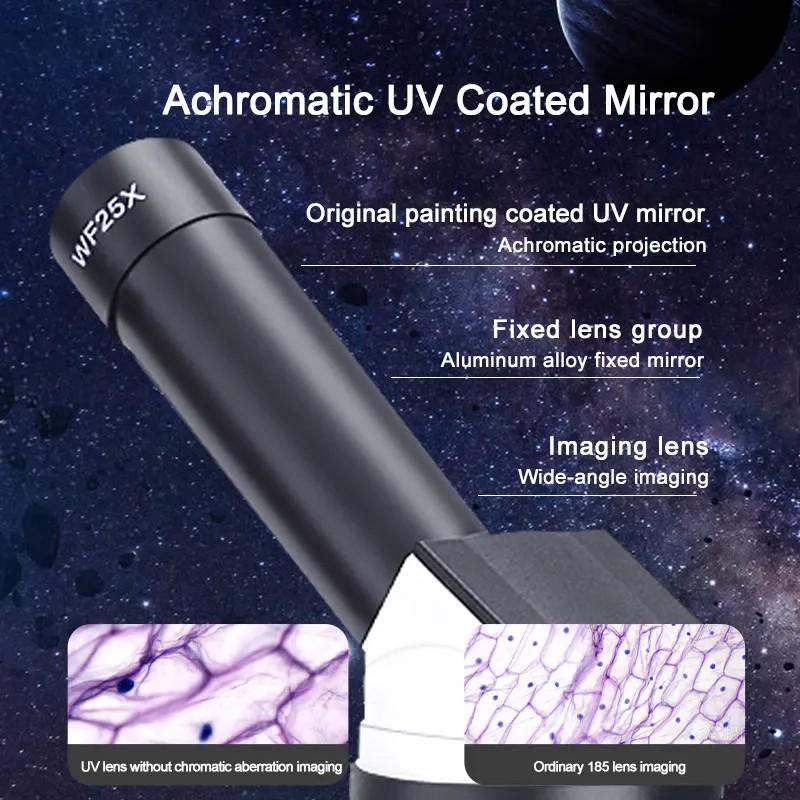What Can You See At 4000x Magnification ?
At 4000x magnification, you can see highly detailed views of microscopic objects such as cells, bacteria, and other small organisms. This level of magnification allows for the observation of intricate structures and fine details that are not visible to the naked eye. It can also reveal the texture, shape, and composition of various materials at a microscopic level.
1、 Cellular structures and organelles in biological samples
At 4000x magnification, one can observe cellular structures and organelles in biological samples with great detail and clarity. This level of magnification allows scientists and researchers to delve deep into the microscopic world and explore the intricate components that make up living organisms.
When examining cells at 4000x magnification, one can observe the nucleus, mitochondria, endoplasmic reticulum, Golgi apparatus, and other organelles. The nucleus, often referred to as the control center of the cell, appears as a distinct structure with a dense, spherical shape. Within the nucleus, one can observe the nucleolus, which plays a crucial role in the production of ribosomes.
Mitochondria, known as the powerhouses of the cell, are visible as elongated structures with a double membrane. These organelles are responsible for generating energy in the form of ATP through cellular respiration. The endoplasmic reticulum, a network of membranous tubules and sacs, can be observed as a complex system within the cell. It plays a vital role in protein synthesis and lipid metabolism.
The Golgi apparatus, often referred to as the cell's packaging and distribution center, appears as a stack of flattened sacs. It is involved in modifying, sorting, and packaging proteins and lipids for transport within and outside the cell.
It is important to note that advancements in microscopy techniques and technologies continue to enhance our understanding of cellular structures and organelles. For instance, the development of super-resolution microscopy techniques has allowed scientists to observe cellular structures at even higher resolutions, surpassing the traditional limits of light microscopy.
In conclusion, at 4000x magnification, one can observe cellular structures and organelles in biological samples, providing valuable insights into the intricate workings of living organisms. However, it is crucial to acknowledge that scientific advancements are constantly pushing the boundaries of what we can observe and understand at the microscopic level.

2、 Fine details of microorganisms and bacteria
At 4000x magnification, one can observe the fine details of microorganisms and bacteria with remarkable clarity. This level of magnification allows scientists and researchers to delve into the intricate world of these tiny organisms, revealing their complex structures and behaviors.
When viewing microorganisms at 4000x magnification, one can observe the intricate details of their cell walls, membranes, and organelles. The high resolution enables scientists to study the morphology and arrangement of these structures, providing valuable insights into their functions and interactions. Additionally, the magnification allows for the observation of cellular processes such as mitosis and meiosis, shedding light on the reproduction and growth of these organisms.
Furthermore, at this level of magnification, scientists can explore the diversity of microorganisms and bacteria. They can identify different species based on their unique characteristics, such as the shape and arrangement of their cells. This knowledge is crucial for understanding the role of microorganisms in various ecosystems, as well as their potential applications in fields such as medicine, agriculture, and biotechnology.
It is important to note that the latest advancements in microscopy techniques, such as electron microscopy, have pushed the boundaries of magnification even further. Electron microscopes can achieve magnifications of up to several million times, allowing for even more detailed observations of microorganisms and bacteria. These cutting-edge technologies have revolutionized our understanding of the microbial world and continue to contribute to groundbreaking discoveries.
In conclusion, at 4000x magnification, one can see the fine details of microorganisms and bacteria, providing valuable insights into their structures, functions, and behaviors. The latest advancements in microscopy techniques have further enhanced our ability to explore the microbial world, opening up new avenues of research and discovery.

3、 Crystal lattice structures in minerals and materials
At 4000x magnification, one can observe crystal lattice structures in minerals and materials. Crystal lattice structures refer to the repeating pattern of atoms or molecules that make up a crystal. This level of magnification allows for a detailed examination of the arrangement and organization of these structures.
When observing minerals, such as quartz or diamond, at 4000x magnification, one can see the intricate network of atoms forming a three-dimensional lattice. This lattice structure gives minerals their unique physical and chemical properties. By studying these structures, scientists can gain insights into the mineral's hardness, transparency, and other characteristics.
In addition to minerals, materials like metals and ceramics also exhibit crystal lattice structures. At 4000x magnification, one can observe the arrangement of atoms or ions in these materials, which determines their mechanical, electrical, and thermal properties. For example, in metals, the lattice structure influences their strength and ductility, while in ceramics, it affects their brittleness and thermal conductivity.
It is important to note that advancements in microscopy techniques have allowed for even higher magnifications and more detailed observations. For instance, with the advent of electron microscopy, scientists can now visualize crystal lattice structures at atomic resolution. This level of magnification provides a deeper understanding of the arrangement of individual atoms within the lattice, leading to breakthroughs in materials science and nanotechnology.
In conclusion, at 4000x magnification, one can see crystal lattice structures in minerals and materials. This level of observation provides valuable insights into the arrangement and organization of atoms or molecules within these structures, contributing to our understanding of their properties and potential applications.

4、 Subcellular components like mitochondria and ribosomes
At a magnification of 4000x, one can observe subcellular components with great detail. These components include mitochondria and ribosomes, which play crucial roles in cellular function.
Mitochondria are often referred to as the "powerhouses" of the cell as they are responsible for generating energy in the form of ATP through cellular respiration. At 4000x magnification, one can observe the distinct double-membrane structure of mitochondria, with the inner membrane forming folds called cristae. These cristae increase the surface area available for ATP production. Additionally, one can observe the matrix, which contains enzymes involved in the citric acid cycle and oxidative phosphorylation.
Ribosomes, on the other hand, are responsible for protein synthesis. They can be found either free in the cytoplasm or attached to the endoplasmic reticulum. At 4000x magnification, ribosomes appear as small granules, often clustered together. These granules consist of two subunits, a larger one and a smaller one, which come together during protein synthesis.
It is important to note that the latest advancements in microscopy techniques, such as electron microscopy, have allowed for even higher magnifications and greater resolution. These advancements have provided researchers with the ability to observe subcellular components in even more detail, revealing intricate structures and interactions within the cell. For example, electron microscopy has revealed the ultrastructure of mitochondria, including the arrangement of cristae and the presence of protein complexes involved in ATP synthesis.
In conclusion, at 4000x magnification, one can observe subcellular components like mitochondria and ribosomes. However, it is worth noting that the latest advancements in microscopy techniques have further enhanced our understanding of these components, allowing for even higher magnifications and greater resolution.





























